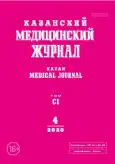Комплексный подход в лечении пациентов с осложнёнными формами гастроэзофагеальной рефлюксной болезни
- Авторы: Морошек А.А.1, Бурмистров М.В.2
-
Учреждения:
- Национальный медицинский исследовательский центр онкологии им. Н.Н. Блохина
- Республиканская клиническая больница
- Выпуск: Том 101, № 4 (2020)
- Страницы: 595-602
- Тип: Обмен клиническим опытом
- URL: https://journal-vniispk.ru/kazanmedj/article/view/21329
- DOI: https://doi.org/10.17816/KMJ2020-595
- ID: 21329
Цитировать
Аннотация
Цель. Обосновать целесообразность применения комплексного лечебного алгоритма, включающего последовательное применение консервативной антирефлюксной терапии и хирургического антирефлюксного лечения, у пациентов с осложнёнными формами гастроэзофагеальной рефлюксной болезни.
Методы. Исследование проведено на выборках из 554 пациентов с осложнёнными формами гастроэзофагеальной рефлюксной болезни (эрозивный эзофагит у 301, пептическая стриктура у 36, пищевод Барретта у 90 и сочетание нескольких осложнений у 127 больных), составивших основную группу, и 229 пациентов с неосложнённой гастроэзофагеальной рефлюксной болезнью, имеющих показания к хирургическому лечению (контрольная группа). На диагностическом этапе в основной и контрольной группах применяли фиброэзофагогастродуоденоскопию с двойной хромоскопией растворами Люголя и метиленового синего и биопсией из участков, подозрительных на метаплазию, а также полипозиционное рентгеноконтрастное исследование пищевода и пищеводно-желудочного перехода с контрастированием бариевой взвесью. На этапе лечения пациенты обеих групп получали консервативную антирефлюксную терапию длительностью 4–8 нед, включающую регламентацию образа жизни, диету, медикаментозную антисекреторную терапию (ингибиторы протонной помпы — омепразол или рабепразол по 20 мг внутрь 2 раза в сутки, эукинетики — домперидон по 20 мг внутрь 3 раза в сутки или итоприд по 50 мг внутрь 3 раза в сутки) и антирефлюксную операцию в виде различных вариантов фундопликации из лапароскопического или лапаротомного доступа, дополненную в основной группе эндоскопической аргоноплазменной коагуляцией у пациентов с пищеводом Барретта в послеоперационном периоде и бужированием пищевода под эндоскопическим контролем в до- и послеоперационном периодах при пептической стриктуре.
Результаты. Частота интраоперационных (6,3%; р=0,0462) и ранних послеоперационных осложнений (41,5%; р=0,0011) в основной группе была статистически значимо выше, чем в контрольной. Клинического значения разница не имела. Частота поздних послеоперационных осложнений в основной группе (5,4%) не имела статистически значимых отличий от контрольной группы (р=0,1239). Комплексный лечебный алгоритм показал себя как безопасный с оговоркой о необходимости разработки мероприятий по снижению общей частоты ранних послеоперационных осложнений. Отличные и удовлетворительные ближайшие результаты лечения были достигнуты у 91,7% (95% доверительный интервал 89,1–93,9), а отличные и удовлетворительные отдалённые результаты — у 91,3% (95% доверительный интервал 88,7–93,5) пациентов основной группы. Они были статистически значимо хуже, чем в контрольной группе, p=0,0008 и p=0,0021 для ближайших и отдалённых результатов соответственно. Разница была обусловлена высокой эффективностью лечебного алгоритма в контрольной группе и клинической значимости не имела.
Вывод. Применение комплексного лечебного алгоритма, основанного на выполнении антирефлюксных операций, целесообразно у всех пациентов с осложнёнными формами гастроэзофагеальной рефлюк-сной болезни.
Полный текст
Открыть статью на сайте журналаОб авторах
Антон Александрович Морошек
Национальный медицинский исследовательский центр онкологии им. Н.Н. Блохина
Автор, ответственный за переписку.
Email: anton.moroshek@mail.ru
Россия, г. Казань, Россия
Михаил Владимирович Бурмистров
Республиканская клиническая больница
Email: anton.moroshek@mail.ru
Россия, г. Казань, Россия
Список литературы
- Багненко С.Ф., Василевский Д.И., Кулагин В.И. Хирургическое лечение гастроэзофагеальной рефлюксной болезни. Руководство для врачей. М.: Litres. 2019; 218 с.
- Dent J., El-Serag H.B., Wallander M.-A. et al. Epidemiology of gastro-oesophageal reflux disease: a systematic review. Gut. 2005; 54: 710–717. doi: 10.1136/gut.2004.051821.
- Бордин Д.С., Колбасников С.В. Гастроэзофагеальная рефлюксная болезнь: от патогенеза к лечению. Леч. врач. 2012; (7): 34.
- Labenz J., Chandrasoma P.T., Knapp L.J., DeMeester T.R. Proposed approach to the challenging management of progressive gastroesophageal reflux disease. World J. Gastrointest. Endosc. 2018; 10 (9): 175. doi: 10.4253/wjge.v10.i9.175.
- Fein M., Ritter M.P., DeMeester T.R. et al. Role of the lower esophageal sphincter and hiatal hernia in the pathogenesis of gastroesophageal reflux disease. J. Gastrointest. Surg.: Official Journal of the Society for Surgery of the Alimentary Tract. 1999; 3: 405–410. doi: 10.1016/s1091-255x(99)80057-2.
- Василевский Д.И., Баландов С.Г., Давлетбаева Л.И., Тарбаев И.С. Пищевод Барретта и аденокарцинома пищевода. Существует ли проблема? Рос. биомед. исследования. 2018; 3 (2): 28–35.
- Шарапов Т.Л., Бурмистров М.В,, Сигал Е.И. и др. Профилактика осложнений при лапароскопических антирефлюксных операциях. Эндоскопич. хир. 2012; (3): 9–14.
- Юрасов А.В., Шестаков А.Л., Битаров Т.Т. Показания к оперативному лечению рефлюкс-эзофагита. Доказательн. гастроэнтерол. 2018; 7 (2): 30–34. doi: 10.17116/dokgastro20187230.
- Seo H.S., Choi M., Son S.-Y. et al. Evidence-based practice guideline for surgical treatment of gastroesophageal reflux disease 2018. J. Gastric Cancer. 2018; 18 (4): 313–327. doi: 10.5230/jgc.2018.18.e41.
Дополнительные файлы






